What an extraordinary experience!
And I’m not saying experience just like that… This was simply all but a usual conference. It’s so different (to anything happened so far in Belgrade) that I continuously struggled to explain people where the hell I am and what kind of a gathering that is. Even now, after the conference, I had to go to their website – www.shareconference.net – in order to find a proper description 🙂
“…is a unique educational platform that represents new forms of social activism, and promotes internet, new media and music related contents, a feat done for the first time in the region.”
So, take a bunch of social and internet activists and media artists, put them in a fantastic new setting of recently renovated Dom Omladine (Youth Center), organize free WiFi, get connected with the internet community to create a hype around it, create a fantastic night program throughout the conference and add a thing or two in the halls to make the atmosphere relaxed and enjoyable, and there you go – Share Conference has begun its, we hope, long and prosperous life in our capital.
The whole program of the conference can be seen on their home page, along with the short biographies of speakers and explanations of almost all sessions, so I won’t go into detailed explanation of all of them, but I’d like to point out a few memorable ones. Memorable for me, that is…
Day 1&3: ImprovEverywhere – Causing a scene
Brian Fountain i Robyn Sklaren shared a story about all the famous videos and activities most of us already knew about (Frozen Grand Central, Grocery Store Musical, Best Buy etc), but now with an extra flavor – background stories, anecdotes, results…
All in all, a hilarious presentation that culminated 2 days later when they organized one of their activities with all of us in downtown Belgrade! 🙂
We gathered in front of Hotel Moscow where we were instructed briefly to split into 3 groups and get into 3 positions downtown respectively. The idea was to create a Mobile Club downtown, with all the possible things one awesome club usually has – walls, great people, music, light show, queue in front, security in dark suits and dark sunglasses, foursquare spot :), and of course a fantastic atmosphere. And what a party it was! Before the videos are out by the organizers, check out a couple of photos here:
Photos credits: ShareConference on Flickr
Day 1: Face2Facebook – Paolo Cirio & Alessandro Ludovico
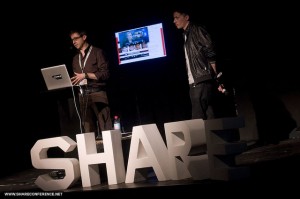
- Photo credits: ShareConference on Flickr
Now these 2 guys are completely nuts! They followed the same path Facebook had when being developed – they downloaded 1 million (yes, one and six zeros) photos from cca 250.000 Facebook profiles, ran a special face recognition algorithm to divide faces into various groups (by facial expressions) and then built a dating website around these photos. If you’ve seen The Social Network movie, you probably know that Zuckerberg did pretty much the same when he built FaceMash.
The theory behind this idea is that Facebook already plays a role on the thin line between a social network and a dating website, because if you look closely into
what kind of data are we asked for and how technology within Facebook is directed into making it easy for us to share photos, statuses and communication in general about our relationships, then it’s easy to draw a conclusion that one of the main things Facebook is being used for is to be a platform to build relationships.
Website they built – www.lovelyfaces.com – did not last long (nor was it supposed to), and they are still fighting legal battle with Facebook (and their accounts were banned for good :)), but nevertheless they are very happy about the outcomes of the project. Along with other initiatives at that time, they succeeded to force Facebook to change their claim over users data, which is a huge success.
During the Q&A session, they didn’t want to reveal future plans, as they are not sure whether they want new legal battles before they finish with current ones 🙂
Day 2: The Copyfight – Peter Sunde (PirateBay & Flattr)
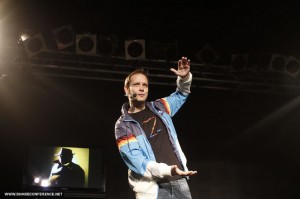
- Photo credits: ShareConference on Flickr
I have to admit – when I checked out the program of the conference for the first time, I did not recognize Peter’s name. Never heard of Flattr before neither. But then, just before his lecture, I realized that it is actually Peter Sunde, one of the founders of ThePirateBay.org, which is, in a way, guilty for almost 60% of today’s internet traffic, as it played a crucial role in popularizing torrents which are today the most popular peer2peer way of sharing files on the internet.
Peter told us about the history of PirateBay, about their legal fights with providers, courts, governments, about how they tried to buy Sealand and were followed by private investigators (stupid ones, but nevertheless), even how Belgrade played a role in the whole story when famous PirateBay bus was hidden in Belgrade during the trials etc.
Don’t know the age span of the participants, but I’m sure that I was not the only one thoroughly enjoying this fantastic story and smiling stupidly as a sign of being happy that I live in this time and that I was a part of the whole story around PirateBay, at least as a simple user of their revolutionary website. My Serbian readers will understand what I’m trying to say if I compare this smile with the one that only those who were old enough to see and actually enjoy the 3 point shots of Djordjevic with Partizan and Serbia can have. 🙂
Peter also shared with us that they are not putting almost any effort in maintaining the website (hence the prehistoric
al design :), and that they would probably shut it down if the server broke today. They are basically keeping it alive because it’s still in top50 sites worldwide (!!!) and people simply use it.
A part of Pirate Bay, he is mostly into developing Flattr.com these days. It’s a social micro-payment/micro-donation system that allows users to put a monthly amount/credit on flattr.com and then user “flattr this” button (similar to FB Like or Google +1). In the end of the month, the credited amount is donated to the flattered websites per flattr-ing ratio. The idea is that they make donations as direct as possible, without expensive middle-men etc. It’s a great project, and I would love to see it working in Serbia soon.
Day 3: Technologies of Empathy – MIT Media Lab – Chris Csikszentmihalyi
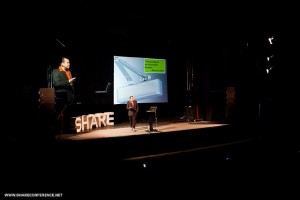
- Photo credits: ShareConference on Flickr
That’s what I call a special guy! He is a director of MIT Center for Future Civic Media, which develops new technologies and techniques to strengthen local communities. Pretty cool, huh? I mean, just mentioning MIT was enough, right? But that’s not the only thing he is special for. Check out his style on this photo and video and you’ll understand why we all tweeted frantically about him for the first 10 minutes of his lecture 🙂
Jokes aside, he was awesome. He spoke honestly about projects they are trying to do to re-balance power between citizens on one and corporations and political factors on the other side. He reminded us that MIT became so big and important because it is one of the biggest defense contractors of the US Army. He also reminded us that most of their work was inspired by the fact that during the Bush rule, government did not share much information about it’s activities, and yet wanted to have and control the data about everyone and everybody. We’re talking about pre-Web2.0 time, of course. Now, Chris argued that government did not ask us whether they can use that info, so what would happen if we just took the info from the government and used it in any way we can think of?
This way of thinking inspired many activities and serviced in the years to come, including Txt2Mob which was a java applet that helped sending SMSs to many recipients via foreign countries’ servers, and all because government instructed phone companies to shut down services protesters in the US used to organize them
selves. There’s apparently a rumor that the source-code of this service was used when Twitter was being developed. How cool is that? 🙂
Chris mentioned many more services and you can explore them at their website, but the one that I loved the most is SourceMap which runs under a motto – “We believe that people have the right to know where things come from and what they are made of”. It’s basically a system that allows you to map literally anything in a structured and organized way. You can also browse many maps that are already in the system, and that are really detailed. I believe that no-one in the room felt completely comfortable after Chris has shown us a video of where and how certain materials that exist in all our smartphones are made. Check out this intro video:
httpv://www.youtube.com/watch?v=g30laGwoYTU
All in all – a great lecture. He definitely marked the day with showing off all the amazing work they do at MIT Media Lab and certainly left many of us drooling and dreaming about being part of it.
Day 3: Deconstructing the role of social media in Tunisian Revolution – Global Voices – Sami Ben Gharbia
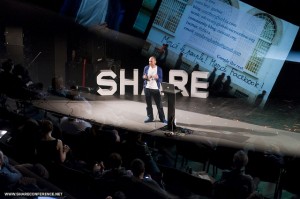 Sami is Tunisian, but lives in exile in the Netherlands where he works as Advocacy director at Global Voices, which “seeks to build a global anti-censorship network of bloggers and online activists dedicated to protecting freedom of expression and free access to information online.”
Sami is Tunisian, but lives in exile in the Netherlands where he works as Advocacy director at Global Voices, which “seeks to build a global anti-censorship network of bloggers and online activists dedicated to protecting freedom of expression and free access to information online.”
He got one of the longest applauses on this year’s conference and for a reason – he deconstructed, step by step and in details the whole story – what, when, how and why it happened. It’s really not easy to explain the whole story in a few sentences, and for that you’ll have to wait for the organizers to upload all lectures (yes, they promised to do so shortly after the conference), but let me just tell you that it was proven that Facebook is good to start the revolution, but Twitter is the one that really brings it to another level (Facebook is a closed platform, you need to be registered and also friends with people or a member of groups if you wanna see news, while twitter is a completely open platform).
Also, it was all about strategy, not tools. Sami presented the 3-way ecosystem, where Facebook, Twitter and other tools is just one part, while 2 others are organizations supporting these kind of activities (human rights, big NGOs etc), and classic media, such are big media networks (CNN, Al Jazeera, BBC etc). As Milos Djajic nicely put it today – it’s about finding a way to get published in influential media. So it’s not just about organizing protests, it’s about creating a hype around it, so that people and organizations get interested continuously. I mean, if 30.000 people protests against Gadaffi and no-one know about it – technically Gadaffi can kill these 30.000 people in a matter of hours probably. But if the eyes of international community are at Libya, then it’s not that easy anymore.
And it helps when government makes stupid steps, like trying to censor internet and specific tools like facebook or posterous, which only brought more people on these platforms.
And this strategy is different in all places – i.e. Facebook and Twitter revolutions were good for Tunisia, but are unlikely to work in Gaza, where internet connection is not so good.
We all followed the situation in Tunisia, but when someone puts it in such a cool presentation and explains why something happened in certain moments, then you realize it’s pretty much modernized version of what Otpor (Resistance) did in Serbia while fighting against Milosevic. As someone putt it nicely – if we had social media back in the nineties, Milosevic would be gone by Dayton Peace Agreement (1995 – Peace in Bosnia).
A really great lecture it was. Too bad that organizers could not set up a video link with Dalia Ziada – an Egyptian blogger and human rights activist, would be cool to hear Egyptian part of the story too…
Conclusion
To conclude, there were more really cool lectures, some I visited and enjoyed (News Analysis, Visualization and Summarization by Institut Jozef Stefan, or Belgrade, beyond an image of a party city by Viktor Markovic from Belgraded.com, Istinomer (Truthmeter)) and some I unfortunately missed (Crisis mapping in Action by Jaroslav Valych, or What makes a movement by Sam Graham Felsen).
And I’ll just say once again how great and inspiring this experience was, that I’m happy that Belgrade and Serbia were hosting such a fantastic conference and that I’m really hoping it will become a tradition.
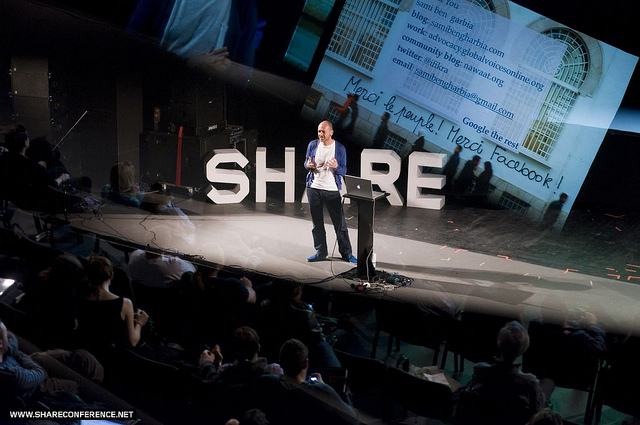
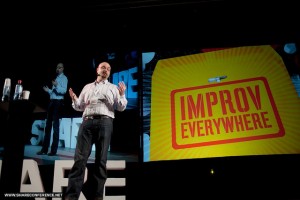
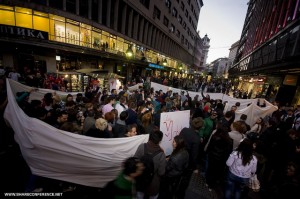

Improve Everywhere – Epic experience
Glad that I’ve been a part of it.
Pingback:MIT Media Lab names Joichi Ito a new director | PećkoPivo
Pingback:Share Conference 2012, Beograd | PećkoPivo